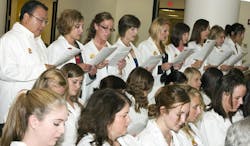The legal impact of dental therapists
By Kimberly Henley-Brown, DDS, MHA, LCDR, USN(R)
July 26, 2013
Dental therapists are expected to supply a need for more dental providers, however some wonder if the training is adequate and what the legal implication is of using dental therapists.
University of Minnesota’s first class of dental therapy students swear an oath. Photo by Emily Jensen, AHC Communications
The high cost of dental insurance and significant shortage of dentists contribute to inadequate access to dental care, which is expanding into a major health crisis. Oral diseases cause deterioration of dental health, which in turn can affect one’s overall health. The new embattled health care reform law does not address poor access to dental care for adults. Studies have found poor dental care can be attributed to the inability to pay for services rendered. Improvements to access to affordable quality dental coverage are not consistent throughout economic, ethnic, and capability levels. Poor access to dental insurance has led many Americans to seek treatment from hospital emergency rooms. Public health officials are actively discussing a strategy to address improving access to dental care by using dental health aide therapists (DHATS) or dental therapists. Dental therapists are expected to supply a need for more dental providers, however some wonder if the training is adequate and what the legal implication is of using dental therapists.
Dental therapy fact sheet, W.K. Kellogg foundation
On August 17, 2012 public health experts held a forum in Washington, D.C. to address the oral health care crisis. Millions of American citizens are not receiving dental care because of financial challenges to determine and sustain quality dental care. Public dental insurance, such as Medicaid or a state Children’s Health Insurance Program (CHIP) covers an estimate of 9% of the uninsured. The ability of states to manage and sustain Medicaid programs is not consistent and most states have no existing Medicaid dental services. For states that have dental services available, it is not guaranteed every individual who qualifies over the age of 21 will receive required dental services. Low rates of dentists accepting Medicaid contributes to inadequate dental care because historically, Medicaid’s reimbursement rates are very low.
The Pew Center for the States found that preventable dental conditions were the primary reason for more than 830,000 emergency room visits in the United States in 2009, up 16% from just three years before. In September 2011, a 24-year-old man died from an infected wisdom tooth because he could not afford antibiotics to treat the infection. The young man was previously told by a dentist the tooth needed to be removed, but he did not have access to quality insurance. Many unemployed individuals with inadequate or no dental insurance are going to the emergency room for dental treatment. Many people who do not have dental insurance find it restrictive and expensive due to high deductibles or caps. Additionally, the prevention of gum disease and tooth decay represents a potential dental care cost savings of 60%, an amount that equals to approximately $100 billion. The forum concluded that oral health care delivery should be part of the larger health care system. Utilizing an alternative workforce model can greatly improve access to dental care.
Experts are eager to use dental health aide therapists or dental therapists as a more effective alternative workforce model. Dental therapists bridge the gap between the hygienist and the dentist, the same as a nurse practitioner or physician assistant practices in a health care setting. The dental therapists treat patients under the supervision of a licensed dentist. Dental therapists provide preventive and restorative care, stainless steel crowns, pulpotomies, and extraction of primary (baby) teeth to the poor and those who live in isolated areas. A polpotomy is performed when the infected pulp chamber is removed, pulp area sterilized, and the chamber sealed. Dental health aide therapists go beyond the barriers of reaching the public on education and prevention of oral diseases. In addition, dental therapists deliver fluoride and sealants as preventive treatment.
More than 82 million Americans continue to struggle to get access to oral health care. The dental shortage continues to be part of a larger and growing health divide between rural and urban America because of income, insurance, and access. Nationally patients have accepted the dental therapists’ role in providing inexpensive quality dental care. Many states have begun to implement the use of dental therapists to provide dental coverage to citizens living in remote rural areas or who cannot afford dental insurance coverage. Alaska was the first state to use dental therapists. In 2005, dental therapists’ work was successfully instituted under federal law; however, their work remains limited to Alaskan indigenous villages. The same workforce model in Minnesota is now being tested. Under a law enacted in 2009, Minnesota is the only state to license dental therapists. Last year, Oregon passed an experimental model to use dental therapists and legislation is proposed in California, New Hampshire, Maine, Vermont, Kansas, and New Mexico.
Op-ed: Dental therapists could help people get care needed in Washington state
Op-ed: Dental therapists not the right fit for Washington state
Many states, Kansas for example, do not have a dental school, which results in a shortage of dentists. Due to the lack of dentists, many have flocked to the emergency room for emergency dental treatment. Kansas lawmakers struggled with the issue, but a plan was rejected because of urging of the dental industry. The bill would have formed a midlevel provider. The registered dental therapist was proposed to be the mid-level provider to perform specific duties managed by dentists. Other states have reflected similar bills but only Alaska and Minnesota have parallel laws. A less expansive plan and a feeble reply to the dental shortage was sent to Kansas’ governor. Supporters pushing for dental therapist legislation contend it would make dental care more available in rural and urban areas. The Kansas Dental Project, a coalition of more than 40 groups, is battling for a mid-level provider.
The model is aggressively opposed by the American Dental Association (ADA). The association does not support the formation of new workforce models because dental therapists are allowed to carry out irreversible dental procedures. The ADA recommends the opening of more dental schools which can train more dentists, who will hopefully practice in urban and rural areas. There are 20 new dental schools proposed to open in the near future. The ADA has strongly argued in several public forums that only a dentist has skills to extract teeth or perform permanent and invasive dental procedures.
In New Mexico, the group Health Action New Mexico is trying to construct a program to initiate dental therapists to service its underserved areas. The group is also actively attempting to change the New Mexico law to distinguish dental therapists under the state’s Dental Practice Act. Powerful adversaries, the American Dental Association and New Mexico Dental Association, are opposed to the use of dental therapists. Both associations agree enhanced laws removing gross receipts taxes on dental services; in addition, proper funding of Medicaid and supporting traditional dental education programs will better serve rural areas.
The W.K. Kellogg Foundation has spent several million dollars training dental therapists in Alaska and studying the safety and effect of using dental therapists. The foundation released a worldwide study in April 2012, which concluded dental therapists practicing in 54 countries and territories made dental care more accessible. Overall, dental therapists tend to have a safe record. Foundation studies also determined the quality of care delivered by dental therapists was comparable and at times exceptional to treatment provided by dentists. However, the American Dental Association has refuted the Kellogg report. The group believes the report is a collection of publications and narratives about the occurrence and use of dental therapists as midlevel providers.
References
Bowman, L. (2012). Medical: Too Many Kids Wind Up in ER for Dental Care. Retrieved from http://www.abcactionnews.com/dpp/lifestyle/wellness/medical-too-many-kids
Cooper, B. (2012). Tooth Watch. Retrieved from http://midwestdemocracy.com/articles/plan-to-provide-more-dental-help-in-kansas-gets-pulled/
Crosby, J. (2012). Dental Therapists Do Some of What Dentist Do in Minnesota, Alaska. Retrieved from http://www.startribune.com/business/162430866.html
Gann, C. (2011). Man Dies From Toothache, Couldn’t Afford Meds. Retrieved from http://abcnews.go.com/Health/insurance-24-year-dies-toothache/story?id=14438171.
Maestas,T. (2010). Shortage of Dentists-Some Call it a Crisis. Retrieved from http://www.krqe.com/dpp/news.
Otto, M. (2012). Oral Health Issues Gain Political Momentum in U.S. Retrieved from http://www.drbicuspid.com/index.aspx/dental.
McGuire, T. (2012). Gum (Periodontal) Disease and Overall Health. Retrieved from http://www.dentalwellness4u.com/oralhealth/disease.html.


